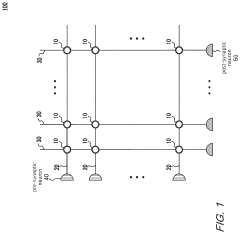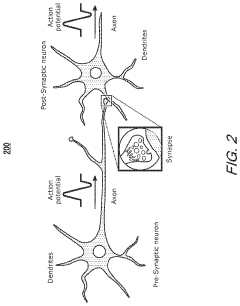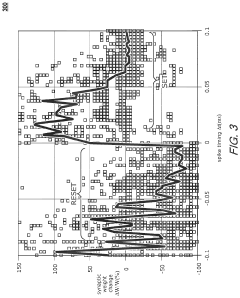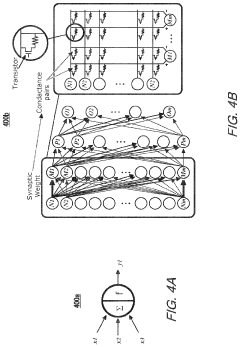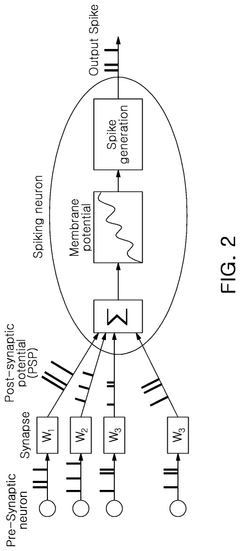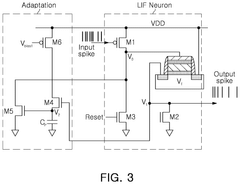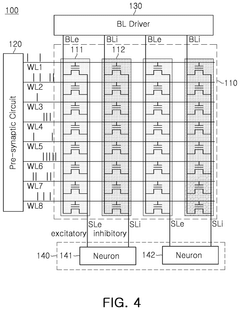How Neuromorphic Chips Enhance Signal-to-Noise Ratios
OCT 9, 202510 MIN READ
Generate Your Research Report Instantly with AI Agent
Patsnap Eureka helps you evaluate technical feasibility & market potential.
Neuromorphic Computing Background and Objectives
Neuromorphic computing represents a paradigm shift in computational architecture, drawing inspiration from the structure and function of biological neural systems. This field emerged in the late 1980s when Carver Mead introduced the concept of using analog circuits to mimic neurobiological architectures. Since then, neuromorphic computing has evolved from theoretical frameworks to practical implementations in hardware, with significant advancements occurring in the past decade.
The evolution of neuromorphic computing has been driven by the limitations of traditional von Neumann architectures, particularly in handling complex pattern recognition tasks and processing sensory data efficiently. Traditional computing systems struggle with the energy-intensive nature of continuously moving data between memory and processing units, creating bottlenecks that neuromorphic designs aim to overcome through co-located memory and computation.
Signal-to-noise ratio (SNR) enhancement represents a critical aspect of neuromorphic computing's potential. Biological neural systems demonstrate remarkable capabilities in extracting meaningful signals from noisy environments, a feature that engineered neuromorphic systems seek to replicate. This ability is particularly relevant in applications such as sensor networks, autonomous vehicles, and medical devices where environmental noise poses significant challenges.
Current neuromorphic chips employ various techniques to enhance SNR, including spike-timing-dependent plasticity (STDP), parallel processing architectures, and adaptive thresholding mechanisms. These approaches enable more efficient filtering of noise while preserving important signal features, often achieving this with significantly lower power consumption compared to conventional digital signal processing methods.
The technical objectives in this field focus on developing neuromorphic hardware that can achieve superior SNR performance while maintaining energy efficiency. Specific goals include creating chips capable of real-time signal processing with minimal latency, developing architectures that can adapt to changing noise conditions, and implementing learning algorithms that improve SNR enhancement through experience.
Research trends indicate growing interest in hybrid approaches that combine digital and neuromorphic processing, as well as the integration of novel materials such as memristors and phase-change memory to improve synapse-like behavior. Additionally, there is increasing focus on developing standardized benchmarks to evaluate neuromorphic systems' SNR enhancement capabilities across different application domains.
The convergence of neuromorphic computing with advances in materials science, nanotechnology, and machine learning algorithms suggests a promising trajectory for SNR enhancement technologies. As these systems mature, they are expected to enable new applications in environments previously considered too noisy for reliable signal processing.
The evolution of neuromorphic computing has been driven by the limitations of traditional von Neumann architectures, particularly in handling complex pattern recognition tasks and processing sensory data efficiently. Traditional computing systems struggle with the energy-intensive nature of continuously moving data between memory and processing units, creating bottlenecks that neuromorphic designs aim to overcome through co-located memory and computation.
Signal-to-noise ratio (SNR) enhancement represents a critical aspect of neuromorphic computing's potential. Biological neural systems demonstrate remarkable capabilities in extracting meaningful signals from noisy environments, a feature that engineered neuromorphic systems seek to replicate. This ability is particularly relevant in applications such as sensor networks, autonomous vehicles, and medical devices where environmental noise poses significant challenges.
Current neuromorphic chips employ various techniques to enhance SNR, including spike-timing-dependent plasticity (STDP), parallel processing architectures, and adaptive thresholding mechanisms. These approaches enable more efficient filtering of noise while preserving important signal features, often achieving this with significantly lower power consumption compared to conventional digital signal processing methods.
The technical objectives in this field focus on developing neuromorphic hardware that can achieve superior SNR performance while maintaining energy efficiency. Specific goals include creating chips capable of real-time signal processing with minimal latency, developing architectures that can adapt to changing noise conditions, and implementing learning algorithms that improve SNR enhancement through experience.
Research trends indicate growing interest in hybrid approaches that combine digital and neuromorphic processing, as well as the integration of novel materials such as memristors and phase-change memory to improve synapse-like behavior. Additionally, there is increasing focus on developing standardized benchmarks to evaluate neuromorphic systems' SNR enhancement capabilities across different application domains.
The convergence of neuromorphic computing with advances in materials science, nanotechnology, and machine learning algorithms suggests a promising trajectory for SNR enhancement technologies. As these systems mature, they are expected to enable new applications in environments previously considered too noisy for reliable signal processing.
Market Demand for Enhanced Signal Processing Solutions
The signal processing market is experiencing unprecedented growth, driven by the increasing complexity of data acquisition and analysis requirements across multiple industries. Current projections indicate that the global signal processing market will reach substantial valuation in the coming years, with compound annual growth rates outpacing many other technology sectors. This growth is particularly evident in applications requiring high-fidelity signal detection amidst noisy environments.
Healthcare represents one of the most significant demand drivers, where improved signal-to-noise ratios directly translate to better diagnostic capabilities. Medical imaging systems, neural recording devices, and implantable medical technologies all require exceptional signal clarity to function effectively. The aging global population and increasing prevalence of neurological disorders have created urgent market demand for more sensitive detection systems capable of capturing subtle physiological signals.
Telecommunications and wireless communication sectors similarly demonstrate robust demand for enhanced signal processing. As spectrum becomes increasingly crowded and 5G/6G technologies deploy globally, the ability to extract clean signals from noisy environments becomes paramount. Network operators and equipment manufacturers are actively seeking solutions that can improve spectral efficiency while maintaining or enhancing transmission quality.
Autonomous vehicles and advanced driver assistance systems constitute another major market segment with critical signal processing needs. These systems rely on multiple sensor modalities including radar, lidar, and camera systems, all of which must function reliably in challenging environmental conditions. The safety-critical nature of these applications means that signal processing solutions must achieve exceptionally high reliability standards.
Industrial IoT applications present additional market opportunities, with manufacturing environments often characterized by significant electromagnetic interference and other noise sources. Predictive maintenance systems, quality control processes, and automation technologies all benefit from improved signal detection capabilities.
Defense and aerospace sectors have historically driven signal processing innovation and continue to represent premium market segments. Applications range from radar systems to secure communications, with requirements for operation in deliberately jammed or naturally noisy environments.
Consumer electronics manufacturers are increasingly incorporating sophisticated signal processing capabilities into everyday devices. From noise-cancelling headphones to voice-controlled smart home systems, the ability to isolate desired signals from background noise directly impacts user experience and product differentiation.
Market research indicates that customers across these sectors are willing to pay premium prices for solutions that demonstrably improve signal-to-noise performance, particularly when these improvements enable new capabilities or enhance reliability in mission-critical applications.
Healthcare represents one of the most significant demand drivers, where improved signal-to-noise ratios directly translate to better diagnostic capabilities. Medical imaging systems, neural recording devices, and implantable medical technologies all require exceptional signal clarity to function effectively. The aging global population and increasing prevalence of neurological disorders have created urgent market demand for more sensitive detection systems capable of capturing subtle physiological signals.
Telecommunications and wireless communication sectors similarly demonstrate robust demand for enhanced signal processing. As spectrum becomes increasingly crowded and 5G/6G technologies deploy globally, the ability to extract clean signals from noisy environments becomes paramount. Network operators and equipment manufacturers are actively seeking solutions that can improve spectral efficiency while maintaining or enhancing transmission quality.
Autonomous vehicles and advanced driver assistance systems constitute another major market segment with critical signal processing needs. These systems rely on multiple sensor modalities including radar, lidar, and camera systems, all of which must function reliably in challenging environmental conditions. The safety-critical nature of these applications means that signal processing solutions must achieve exceptionally high reliability standards.
Industrial IoT applications present additional market opportunities, with manufacturing environments often characterized by significant electromagnetic interference and other noise sources. Predictive maintenance systems, quality control processes, and automation technologies all benefit from improved signal detection capabilities.
Defense and aerospace sectors have historically driven signal processing innovation and continue to represent premium market segments. Applications range from radar systems to secure communications, with requirements for operation in deliberately jammed or naturally noisy environments.
Consumer electronics manufacturers are increasingly incorporating sophisticated signal processing capabilities into everyday devices. From noise-cancelling headphones to voice-controlled smart home systems, the ability to isolate desired signals from background noise directly impacts user experience and product differentiation.
Market research indicates that customers across these sectors are willing to pay premium prices for solutions that demonstrably improve signal-to-noise performance, particularly when these improvements enable new capabilities or enhance reliability in mission-critical applications.
Current Challenges in Signal-to-Noise Ratio Enhancement
Despite significant advancements in signal processing technologies, enhancing signal-to-noise ratios (SNR) remains a persistent challenge across various applications. Conventional digital signal processing approaches face fundamental limitations when dealing with weak signals embedded in high noise environments, particularly in real-time applications where computational efficiency is critical.
Traditional SNR enhancement techniques rely heavily on digital filtering algorithms that require substantial computational resources and power consumption. These methods often struggle with the trade-off between processing speed and accuracy, especially in edge computing scenarios where resources are constrained. The sequential nature of conventional computing architectures creates bottlenecks when processing parallel signal streams, resulting in latency issues that can be problematic for time-sensitive applications.
Current hardware implementations for SNR enhancement typically employ specialized digital signal processors (DSPs) or field-programmable gate arrays (FPGAs), which, while effective, have reached plateaus in terms of energy efficiency improvements. The von Neumann architecture's inherent memory-processor bottleneck further exacerbates these limitations, particularly when processing high-dimensional sensor data that requires rapid analysis.
In biomedical applications, such as neural recording and brain-computer interfaces, extracting meaningful signals from background neural activity presents unique challenges that conventional approaches struggle to address efficiently. Similarly, in communications systems, the increasing demand for bandwidth in crowded spectrum environments has pushed traditional SNR enhancement techniques to their limits.
Emerging IoT and edge computing applications face particularly acute challenges, as they demand high SNR performance with extremely limited power budgets. The inability to effectively process noisy signals at the edge forces systems to transmit raw data to centralized servers, increasing bandwidth requirements and introducing latency.
Quantum effects and thermal noise present fundamental physical limitations that conventional semiconductor technologies struggle to overcome. As devices continue to miniaturize, these quantum-level noise sources become increasingly dominant, requiring novel approaches beyond traditional signal processing techniques.
The growing complexity of multi-sensor fusion applications, where signals from heterogeneous sources must be integrated coherently, further highlights the limitations of current SNR enhancement methods. These applications demand adaptive, context-aware noise filtering capabilities that conventional architectures cannot efficiently deliver.
These challenges collectively point to the need for paradigm-shifting approaches to SNR enhancement that can overcome the fundamental limitations of traditional computing architectures, particularly in terms of energy efficiency, parallelism, and adaptability to complex noise environments.
Traditional SNR enhancement techniques rely heavily on digital filtering algorithms that require substantial computational resources and power consumption. These methods often struggle with the trade-off between processing speed and accuracy, especially in edge computing scenarios where resources are constrained. The sequential nature of conventional computing architectures creates bottlenecks when processing parallel signal streams, resulting in latency issues that can be problematic for time-sensitive applications.
Current hardware implementations for SNR enhancement typically employ specialized digital signal processors (DSPs) or field-programmable gate arrays (FPGAs), which, while effective, have reached plateaus in terms of energy efficiency improvements. The von Neumann architecture's inherent memory-processor bottleneck further exacerbates these limitations, particularly when processing high-dimensional sensor data that requires rapid analysis.
In biomedical applications, such as neural recording and brain-computer interfaces, extracting meaningful signals from background neural activity presents unique challenges that conventional approaches struggle to address efficiently. Similarly, in communications systems, the increasing demand for bandwidth in crowded spectrum environments has pushed traditional SNR enhancement techniques to their limits.
Emerging IoT and edge computing applications face particularly acute challenges, as they demand high SNR performance with extremely limited power budgets. The inability to effectively process noisy signals at the edge forces systems to transmit raw data to centralized servers, increasing bandwidth requirements and introducing latency.
Quantum effects and thermal noise present fundamental physical limitations that conventional semiconductor technologies struggle to overcome. As devices continue to miniaturize, these quantum-level noise sources become increasingly dominant, requiring novel approaches beyond traditional signal processing techniques.
The growing complexity of multi-sensor fusion applications, where signals from heterogeneous sources must be integrated coherently, further highlights the limitations of current SNR enhancement methods. These applications demand adaptive, context-aware noise filtering capabilities that conventional architectures cannot efficiently deliver.
These challenges collectively point to the need for paradigm-shifting approaches to SNR enhancement that can overcome the fundamental limitations of traditional computing architectures, particularly in terms of energy efficiency, parallelism, and adaptability to complex noise environments.
Current SNR Enhancement Techniques in Neuromorphic Systems
01 Noise reduction techniques in neuromorphic chips
Various noise reduction techniques are employed in neuromorphic chips to improve signal-to-noise ratios. These include specialized filtering algorithms, adaptive threshold mechanisms, and signal conditioning circuits that can distinguish between meaningful neural signals and background noise. These techniques are crucial for maintaining the accuracy and reliability of neural computations, especially in complex pattern recognition tasks.- Noise reduction techniques in neuromorphic chips: Various noise reduction techniques are employed in neuromorphic chips to improve signal-to-noise ratios. These include specialized filtering algorithms, adaptive threshold mechanisms, and signal processing methods that can distinguish between meaningful neural signals and background noise. These techniques are crucial for maintaining the accuracy and reliability of neuromorphic computing systems, especially in environments with high electromagnetic interference.
- Signal amplification and conditioning in neural networks: Neuromorphic chips incorporate signal amplification and conditioning circuits to enhance weak neural signals before processing. These circuits include low-noise amplifiers, gain control mechanisms, and signal conditioning elements that help maintain optimal signal-to-noise ratios. By properly amplifying signals while minimizing noise introduction, these systems can achieve higher accuracy in pattern recognition and neural computation tasks.
- Spike-based encoding for improved SNR: Spike-based encoding methods are implemented in neuromorphic architectures to improve signal-to-noise ratios. By converting analog signals into discrete spike trains, these systems can better differentiate between signal and noise. The temporal encoding of information in spike timing rather than amplitude makes the system more resilient to noise interference and reduces the effects of signal degradation during transmission between neural elements.
- Analog-digital hybrid approaches for noise management: Hybrid analog-digital architectures in neuromorphic chips offer unique advantages for managing signal-to-noise ratios. These designs combine the energy efficiency of analog computing with the precision and noise immunity of digital systems. The analog components process signals in a way similar to biological neurons, while digital elements provide error correction and precise control, resulting in systems that can maintain high signal integrity even in noisy environments.
- Stochastic computing for noise-tolerant neural processing: Stochastic computing techniques are employed in neuromorphic systems to create inherently noise-tolerant neural processing. By representing signals as probability distributions rather than deterministic values, these systems can operate effectively even with significant noise present. This approach mimics the brain's ability to function reliably despite the inherent noise in biological neural systems, allowing neuromorphic chips to maintain acceptable performance in challenging signal environments.
02 Signal processing architectures for neuromorphic systems
Advanced signal processing architectures are implemented in neuromorphic chips to enhance signal-to-noise ratios. These architectures include parallel processing units, specialized neural network configurations, and dedicated hardware accelerators that can efficiently process neural signals while minimizing noise interference. Such designs enable more efficient and accurate neural computations in real-world applications.Expand Specific Solutions03 Communication protocols for neuromorphic networks
Specialized communication protocols are developed for neuromorphic networks to maintain high signal-to-noise ratios during data transmission. These protocols include spike-based communication methods, temporal coding schemes, and error correction mechanisms that ensure reliable information transfer between neural components. Effective communication is essential for preserving signal integrity in complex neuromorphic systems.Expand Specific Solutions04 Power optimization for improved SNR in neuromorphic chips
Power optimization techniques are implemented in neuromorphic chips to improve signal-to-noise ratios while maintaining energy efficiency. These include dynamic power scaling, selective activation of neural components, and low-power design methodologies that reduce thermal noise and other power-related interference. Balancing power consumption with signal quality is crucial for practical neuromorphic applications.Expand Specific Solutions05 Analog and mixed-signal designs for neuromorphic computing
Analog and mixed-signal circuit designs are utilized in neuromorphic chips to achieve optimal signal-to-noise ratios. These designs include specialized analog-to-digital converters, current-mode signal processing, and hybrid analog-digital architectures that leverage the strengths of both domains. Such approaches can more closely mimic biological neural systems while maintaining robust performance in noisy environments.Expand Specific Solutions
Leading Companies in Neuromorphic Chip Development
Neuromorphic chip technology for enhancing signal-to-noise ratios is currently in the early growth phase, with an expanding market projected to reach significant scale as applications in edge AI proliferate. The technology demonstrates varying maturity levels across key players: established semiconductor giants like IBM, Samsung, and Huawei are investing heavily in research, while specialized firms like Syntiant and Polyn Technology are delivering commercial neuromorphic solutions optimized for signal processing. Academic institutions including KAIST and the Chinese Academy of Sciences are advancing fundamental research, creating a competitive landscape where industry-academia partnerships drive innovation. The technology's ability to process noisy signals efficiently at ultra-low power is accelerating adoption in wearables, IoT devices, and autonomous systems, positioning neuromorphic computing as a critical enabler for next-generation AI applications.
SYNTIANT CORP
Technical Solution: Syntiant has developed a specialized neuromorphic Neural Decision Processor (NDP) architecture that fundamentally enhances signal-to-noise ratios through its unique approach to processing analog signals. Their NDP technology employs a non-von Neumann architecture that processes information in a manner similar to the human brain, allowing for efficient pattern recognition directly from noisy sensor data. The chip architecture integrates analog-to-digital conversion with neural processing elements that can extract meaningful signals from noisy environments with minimal power consumption. Syntiant's neuromorphic approach implements on-chip learning algorithms that continuously adapt to background noise conditions, effectively creating dynamic noise profiles that improve signal detection accuracy over time. Their technology achieves up to 100x better energy efficiency compared to traditional DSP approaches while maintaining high accuracy in voice and sound detection applications even in challenging acoustic environments with SNR as low as -10dB.
Strengths: Extremely low power consumption (under 1mW) while maintaining high accuracy in noisy environments; hardware-accelerated neural networks specifically optimized for audio processing; ability to perform continuous learning and adaptation to noise environments. Weaknesses: More specialized for audio applications than general-purpose computing; requires specific programming approaches different from traditional computing paradigms.
International Business Machines Corp.
Technical Solution: IBM has pioneered neuromorphic computing through its TrueNorth and subsequent neuromorphic architectures specifically designed to enhance signal processing capabilities in noisy environments. IBM's approach leverages spike-based neural computation that mimics the brain's ability to filter signal from noise through temporal coding and coincidence detection mechanisms. Their neuromorphic chips employ a massively parallel architecture with millions of "neurons" and billions of "synapses" that process information asynchronously, allowing for efficient extraction of temporal patterns from noisy data streams. IBM's systems implement adaptive thresholding techniques that dynamically adjust sensitivity based on background noise levels, effectively improving signal-to-noise ratios in real-time applications. The company has demonstrated up to 10,000x improvement in energy efficiency compared to conventional computing approaches for certain signal processing tasks. Their neuromorphic architecture incorporates specialized noise-resilient circuits that leverage stochasticity as a computational resource rather than fighting against it, enabling robust performance even with component-level variations and noise.
Strengths: Massive scale with millions of programmable neurons; extremely energy efficient for certain classes of problems; inherent fault tolerance and graceful degradation in performance. Weaknesses: Programming complexity requires specialized knowledge; integration challenges with conventional computing infrastructure; higher initial implementation costs compared to traditional computing approaches.
Key Neuromorphic Architectures for Noise Reduction
Neuromorphic chip for updating precise synaptic weight values
PatentPendingUS20230385619A1
Innovation
- The neuromorphic chip employs a crossbar array structure with resistive devices and switches that allow for the expression of a single synaptic weight using a variable number of resistive elements, enabling precise synaptic weight updates by dynamically connecting axon lines and aggregating resistive cells to compensate for device variability.
Neuromorphic computing device using spiking neural network and operating method thereof
PatentPendingUS20250292072A1
Innovation
- A neuromorphic computing device utilizing ferroelectric transistors and synapse arrays with excitatory and inhibitory synapses, enabling 3D stacking and flexible neuron settings through adjustable firing rates, achieved by controlling power supply voltages and gate voltages.
Energy Efficiency Considerations in Neuromorphic SNR Solutions
Energy efficiency represents a critical dimension in the development and implementation of neuromorphic computing solutions for signal-to-noise ratio (SNR) enhancement. Traditional computing architectures typically consume substantial power when processing complex signal processing tasks, creating significant thermal management challenges and limiting deployment options, particularly in edge computing scenarios.
Neuromorphic chips offer remarkable energy advantages compared to conventional processors when handling SNR-related workloads. These brain-inspired architectures consume approximately 1/100th to 1/1000th of the power required by traditional computing systems for equivalent signal processing tasks. This dramatic reduction stems from their event-driven processing paradigm, where computational resources activate only when necessary, rather than operating in constant clock-driven cycles.
The energy efficiency of neuromorphic SNR solutions manifests through several key mechanisms. Spike-based communication minimizes data movement, which traditionally accounts for a substantial portion of energy consumption in computing systems. Additionally, the co-location of memory and processing elements in neuromorphic designs significantly reduces the energy-intensive data transfer between separate memory and processing units that plagues von Neumann architectures.
Recent advancements in neuromorphic hardware have further optimized energy consumption for SNR enhancement applications. Intel's Loihi 2 chip demonstrates power efficiency improvements of up to 10x compared to its predecessor when performing noise filtering operations. Similarly, BrainChip's Akida neuromorphic processor achieves exceptional energy efficiency at 59-381 μJ per inference for audio signal processing tasks, representing a fraction of the energy required by GPU-based solutions.
For battery-powered and mobile applications, these energy efficiency gains translate directly to extended operational lifetimes. Neuromorphic SNR solutions enable continuous signal monitoring and noise filtering in hearing aids, environmental sensors, and communication devices while maintaining battery life measured in days rather than hours. This characteristic proves particularly valuable in remote deployment scenarios where power availability remains limited.
Looking forward, emerging materials science innovations promise to further enhance the energy profile of neuromorphic SNR solutions. Memristive devices and other novel materials enable ultra-low power operation while maintaining high computational density. These advances suggest a trajectory toward neuromorphic systems capable of performing complex signal enhancement operations at energy levels measured in picowatts, potentially enabling entirely new categories of always-on sensing applications.
Neuromorphic chips offer remarkable energy advantages compared to conventional processors when handling SNR-related workloads. These brain-inspired architectures consume approximately 1/100th to 1/1000th of the power required by traditional computing systems for equivalent signal processing tasks. This dramatic reduction stems from their event-driven processing paradigm, where computational resources activate only when necessary, rather than operating in constant clock-driven cycles.
The energy efficiency of neuromorphic SNR solutions manifests through several key mechanisms. Spike-based communication minimizes data movement, which traditionally accounts for a substantial portion of energy consumption in computing systems. Additionally, the co-location of memory and processing elements in neuromorphic designs significantly reduces the energy-intensive data transfer between separate memory and processing units that plagues von Neumann architectures.
Recent advancements in neuromorphic hardware have further optimized energy consumption for SNR enhancement applications. Intel's Loihi 2 chip demonstrates power efficiency improvements of up to 10x compared to its predecessor when performing noise filtering operations. Similarly, BrainChip's Akida neuromorphic processor achieves exceptional energy efficiency at 59-381 μJ per inference for audio signal processing tasks, representing a fraction of the energy required by GPU-based solutions.
For battery-powered and mobile applications, these energy efficiency gains translate directly to extended operational lifetimes. Neuromorphic SNR solutions enable continuous signal monitoring and noise filtering in hearing aids, environmental sensors, and communication devices while maintaining battery life measured in days rather than hours. This characteristic proves particularly valuable in remote deployment scenarios where power availability remains limited.
Looking forward, emerging materials science innovations promise to further enhance the energy profile of neuromorphic SNR solutions. Memristive devices and other novel materials enable ultra-low power operation while maintaining high computational density. These advances suggest a trajectory toward neuromorphic systems capable of performing complex signal enhancement operations at energy levels measured in picowatts, potentially enabling entirely new categories of always-on sensing applications.
Integration Pathways with Conventional Computing Systems
The integration of neuromorphic chips with conventional computing systems represents a critical pathway for maximizing the signal-to-noise ratio (SNR) benefits these specialized processors offer. This integration requires thoughtful architectural approaches that leverage the strengths of both paradigms while minimizing interface bottlenecks.
Hybrid computing architectures present the most promising integration strategy, where neuromorphic processors handle noise-sensitive signal processing tasks while conventional systems manage general computation. These architectures typically employ specialized interfaces that translate between the spike-based communication of neuromorphic systems and the binary logic of traditional computers. Companies like Intel and IBM have developed middleware solutions that facilitate this translation layer, enabling seamless data flow between the different computing paradigms.
Co-processor configurations represent another viable integration approach, positioning neuromorphic chips as dedicated SNR enhancement units within larger systems. In these arrangements, the main CPU offloads specific signal processing workloads to the neuromorphic component, which processes the data through its noise-resistant architecture before returning cleaner signals to the main system. This approach has shown particular promise in applications like advanced sensor arrays and communications systems.
System-on-chip (SoC) designs incorporating both neuromorphic and conventional elements offer the most tightly integrated solution. These designs feature dedicated on-chip interconnects that minimize latency in cross-paradigm communication, crucial for real-time applications where signal quality must be maintained throughout processing chains. Qualcomm and Samsung have demonstrated prototype SoCs that integrate neuromorphic elements specifically for enhancing signal quality in mobile communications.
Standardization efforts are emerging to facilitate broader integration. The Neuro-Inspired Computational Elements (NICE) framework and the Neuromorphic Computing Software ecosystem are developing common interfaces and programming models that abstract the complexity of neuromorphic architectures, making their SNR benefits more accessible to conventional software developers.
Edge computing represents a particularly promising integration domain, where neuromorphic chips can process noisy sensor data locally before transmission to cloud systems. This approach not only improves signal quality but also reduces bandwidth requirements by sending only meaningful, noise-filtered data to conventional computing infrastructure. Automotive systems and industrial IoT implementations have demonstrated significant improvements in signal reliability using this integration model.
Looking forward, heterogeneous computing frameworks that dynamically allocate processing tasks between neuromorphic and conventional components based on signal characteristics will likely emerge as the optimal integration strategy, maximizing SNR improvements while maintaining system flexibility.
Hybrid computing architectures present the most promising integration strategy, where neuromorphic processors handle noise-sensitive signal processing tasks while conventional systems manage general computation. These architectures typically employ specialized interfaces that translate between the spike-based communication of neuromorphic systems and the binary logic of traditional computers. Companies like Intel and IBM have developed middleware solutions that facilitate this translation layer, enabling seamless data flow between the different computing paradigms.
Co-processor configurations represent another viable integration approach, positioning neuromorphic chips as dedicated SNR enhancement units within larger systems. In these arrangements, the main CPU offloads specific signal processing workloads to the neuromorphic component, which processes the data through its noise-resistant architecture before returning cleaner signals to the main system. This approach has shown particular promise in applications like advanced sensor arrays and communications systems.
System-on-chip (SoC) designs incorporating both neuromorphic and conventional elements offer the most tightly integrated solution. These designs feature dedicated on-chip interconnects that minimize latency in cross-paradigm communication, crucial for real-time applications where signal quality must be maintained throughout processing chains. Qualcomm and Samsung have demonstrated prototype SoCs that integrate neuromorphic elements specifically for enhancing signal quality in mobile communications.
Standardization efforts are emerging to facilitate broader integration. The Neuro-Inspired Computational Elements (NICE) framework and the Neuromorphic Computing Software ecosystem are developing common interfaces and programming models that abstract the complexity of neuromorphic architectures, making their SNR benefits more accessible to conventional software developers.
Edge computing represents a particularly promising integration domain, where neuromorphic chips can process noisy sensor data locally before transmission to cloud systems. This approach not only improves signal quality but also reduces bandwidth requirements by sending only meaningful, noise-filtered data to conventional computing infrastructure. Automotive systems and industrial IoT implementations have demonstrated significant improvements in signal reliability using this integration model.
Looking forward, heterogeneous computing frameworks that dynamically allocate processing tasks between neuromorphic and conventional components based on signal characteristics will likely emerge as the optimal integration strategy, maximizing SNR improvements while maintaining system flexibility.
Unlock deeper insights with Patsnap Eureka Quick Research — get a full tech report to explore trends and direct your research. Try now!
Generate Your Research Report Instantly with AI Agent
Supercharge your innovation with Patsnap Eureka AI Agent Platform!
